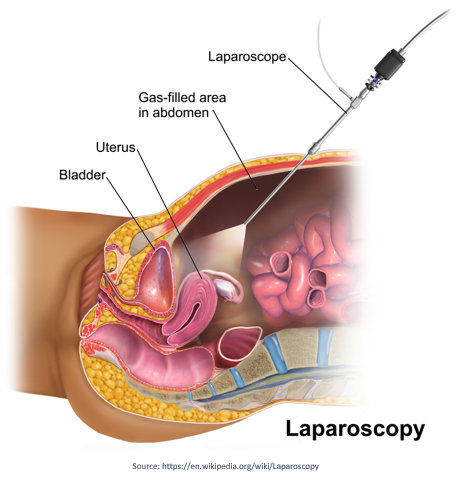
Fibroids Treatment in Mumbai
 Uterine fibroids are a type of noncancerous tumor that can grow inside and outside of the uterus. These growths can be extremely painful and disrupt a woman’s life.
Uterine fibroids are a type of noncancerous tumor that can grow inside and outside of the uterus. These growths can be extremely painful and disrupt a woman’s life.
Fibroids do not always cause symptoms, but when they do, they can cause heavy menstrual bleeding, frequent urination, back pain, and discomfort during intercourse. Small fibroids may not require treatment, but larger fibroids may require medication or surgery.
Because fibroids rarely cause symptoms, they are often detected by chance during a routine gynecological examination, test, or scan. If you have persistent symptoms of fibroids, consult a seasoned gynaecologist in Mumbai. So, they can investigate possible causes and confirm the diagnosis.
Budget Fertility Centre offers advanced & result-oriented fibroids treatment in Mumbai. Our team comprises highly qualified and experienced gynaecologists in Mumbai who are skilled in both medical and surgical treatment of fibroids.
In this article, we will look at the different kinds of uterine fibroids, the causes, symptoms, diagnosis, and treatment of uterine fibroids in Mumbai.
Your journey to gynecological well-being starts with a conversation.
What are the different types of fibroids?

Fibroids can develop anywhere in the womb and vary in size. Some are small as a pea, while others are as large as a melon.
The following are the most common types of fibroids:
- Intramural fibroids: The most common type of fibroid that develops in the uterus’s muscle wall.
- Subserosal fibroids: They develop outside the uterus’s wall into the pelvis and can grow to be very large.
- Submucosal fibroids: These develop in the muscle layer under the uterine lining and grow into the uterine cavity.
Subserosal or submucosal fibroids are sometimes attached to the uterus by a narrow stalk of tissue. These are referred to as pedunculated fibroids.
What causes fibroids?
However, several other factors may also influence their formation.
- Hormones: Ovaries produce oestrogen and progesterone hormones. During each menstrual cycle, they cause regeneration of the uterine wall and may stimulate the formation of fibroids.
- Family history: Fibroids may run in families. You may develop this condition if your grandmother, mother, or sister has a history of fibroids.
- Pregnancy: Pregnancy causes your body to produce more oestrogen and progesterone. Fibroids can form and grow quickly while you are pregnant.
Who is at risk for uterine fibroids?
- Pregnancy
- Obesity
- 30 years old or older
- Family history of fibroids.
- Having no children.
- Menstruation begins too soon at a young age.
- Menopause occurs at a late age.
What are the symptoms of fibroids?
- heavy or painful periods.
- abdominal pain
- lower backache
- constipation
- urge to urinate frequently
- discomfort or pain during intercourse
Further complications caused by fibroids can affect pregnancy or cause infertility in rare cases.
Your journey to gynecological well-being starts with a conversation.
How are fibroids diagnosed?
Several tests can confirm fibroids’ presence and determine their size and location. These tests may include the following:

- Ultrasonography: This non-invasive imaging test uses sound waves to create a picture of the internal organs.
- MRI scan: It uses magnetic and radio waves to create detailed images of the internal organs.
- CT scan: This imaging test uses X-rays to create a detailed image of the internal organs from various angles.
- Hysteroscopy: During a hysteroscopy, the doctor will examine fibroids inside the uterus using a hysteroscope, a thin, flexible tube with a camera on one end. Then, the scope is passed through the vagina and cervix and moved into the uterus.

- Hysterosalpingography (HSG): It is a detailed X-ray in which the doctor injects a contrast material, followed by X-rays of the uterus. Experts often perform it in women who are being evaluated for infertility.

- Sonohysterography: In this imaging test, the doctor inserts a small catheter transvaginally and injects saline into the uterine cavity through the catheter. The saline aids in creating a clearer image of the uterus than a standard ultrasound would.
- Laparoscopy: During this test, the doctor makes small incisions in the lower abdomen. Then, the doctor inserts the laparoscope, a thin, flexible tube with a camera on its end to examine the internal organs closely.
How are fibroids treated?
If you have fibroids that need treatment, your doctor may prescribe medication to help alleviate your symptoms.
However, if these treatments are ineffective, you may need to see a gynaecologist for additional medication or surgery.
You can consult with one of our seasoned gynaecologists to receive the best fibroids treatment in Mumbai.
Following are the various fibroids treatment options:
1. Medications
- Over-the-counter (OTC) pain relievers: OTC pain relievers can help with the discomfort and pain caused by fibroids.
- Iron supplements: If you have anemia due to excessive bleeding, your doctor may prescribe an iron supplement.
- Birth control: It can help with fibroids symptoms, such as heavy bleeding during and between menstrual cycles and menstrual cramps.
- Gonadotropin-releasing hormone (GnRH) agonists: These medications, administered as a nasal spray or injection, work by shrinking the fibroids. They are sometimes used to shrink a fibroid before surgery to make removal easier. However, these medications are only temporary, and if you stop taking them, the fibroids may recur.
It is critical to discuss any medication you take with your doctor. Before beginning a new medication, consult your doctor to discuss any potential complications.
2. Fibroid Removal Surgery
When discussing the various types of surgery for fibroid removal, several factors are to consider. Not only can the size, location, and the number of fibroids influence the type of surgery, but your preferences for future pregnancies can also play a role in developing a treatment plan.
Some surgical options retain the uterus and allow you to conceive in the future, while others either damage or remove the uterus.
Myomectomy is a procedure that allows the doctor to remove fibroids without causing any damage to the uterus. There are several myomectomy procedures to remove fibroids, including the following:
- Hysteroscopy: This procedure entails inserting a hysteroscope, a thin, flexible tube-like tool, through the vagina and cervix and into the uterus. During the Hysteroscopy procedure, the doctor makes no incisions. The doctor uses the scope to cut away and remove the fibroids during the procedure.
- Laparoscopy: This procedure involves using a laparoscope to remove the fibroids. It entails making several small incisions in the abdomen. The scope will enter and exit the body in this manner.

- Laparotomy: This procedure involves making an incision in the abdomen and removing the fibroids through one large incision.
If you have no plans for future pregnancies, your doctor may recommend additional surgical options. These fibroids removal surgeries may include:
- Hysterectomy: This procedure involves the complete removal of the uterus. A hysterectomy is the only option to treat fibroids permanently. By removing your uterus completely, the fibroids can’t return, and your symptoms should go away. If your uterus is removed, but your ovaries remain, you will not experience menopause after a hysterectomy. Your doctor may recommend this procedure; if you are experiencing heavy bleeding from your fibroids or have large fibroids.
- Uterine fibroid embolization: An interventional radiologist performs this procedure in collaboration with your gynaecologist. The doctor inserts a small catheter into the uterine or radial artery and uses tiny particles to block blood flow from the uterine artery to the fibroids. The loss of blood flow causes the fibroids to shrink, which improves your symptoms.
- Radiofrequency ablation (RFA): This is a safe and effective treatment for symptomatic uterine fibroids. Doctors may perform this procedure using laparoscopic, transvaginal, or transcervical methods.
We hope you learned something about the uterine fibroids and that this information will help you better understand what to do if you encounter this type of problem.
Book Your Appointment now!
Frequently Asked Questions
Uterine fibroids can pressure the uterine lining, causing more bleeding than usual. Because the uterus may not contract properly, it cannot stop the bleeding. Fibroids can cause blood vessel growth, contributing to heavier or irregular periods and spotting between periods.
Fibroids are not life-threatening, but depending on their location in the uterus and size, they can cause pain and discomfort that can be relieved with medical care.
Depending on the number of fibroids and their size, laparoscopic myomectomy can take two to four hours. Depending on how you feel after the procedure, you can go home the same day or spend the night in the hospital.
Surgery may be the best option if a woman has severe symptoms and the fibroids are in the muscle or outside the uterus. Laparoscopic myomectomy is more common in this case.
Fibroids in the uterus can continue to grow in size and number if left untreated. Bleeding will become heavier, and severe cramping and anemia may occur. The abdomen may swell as the fibroids grow.
